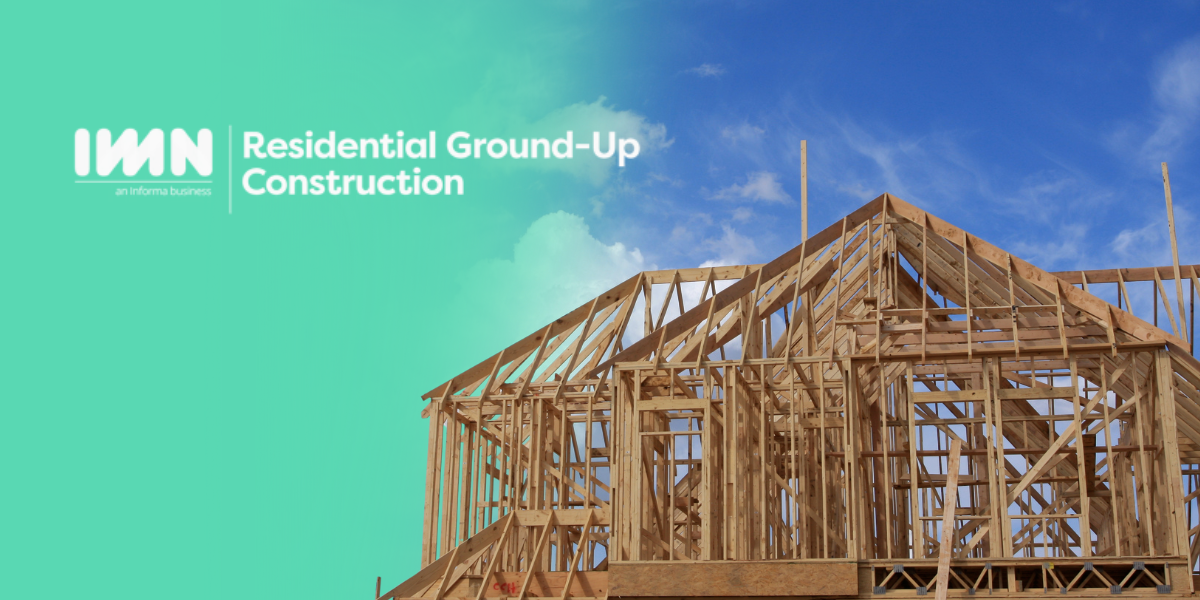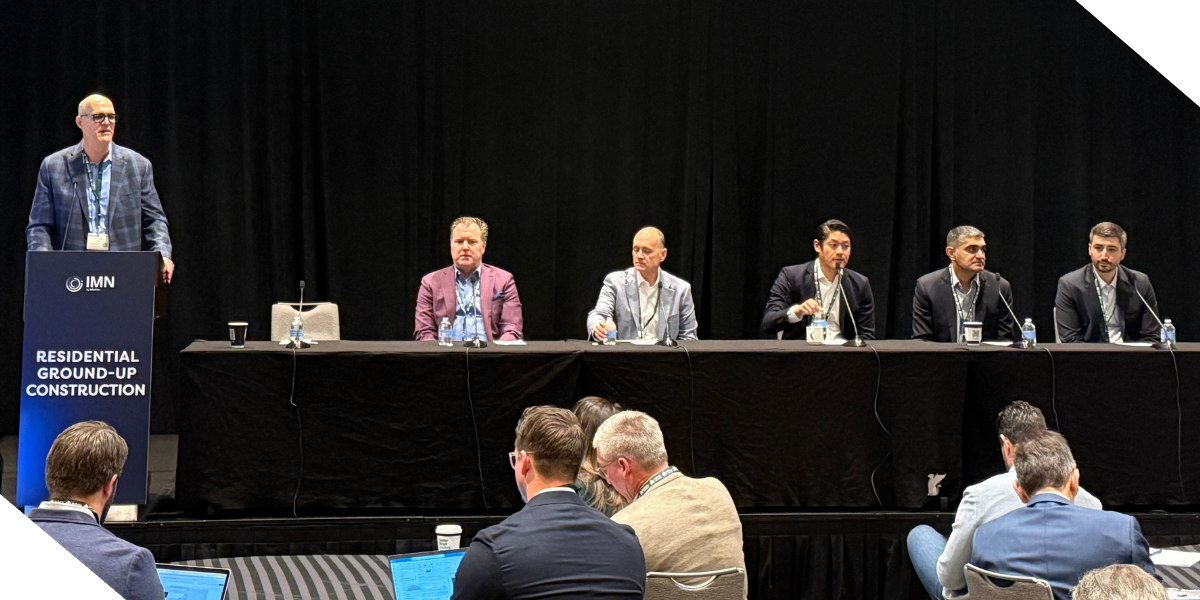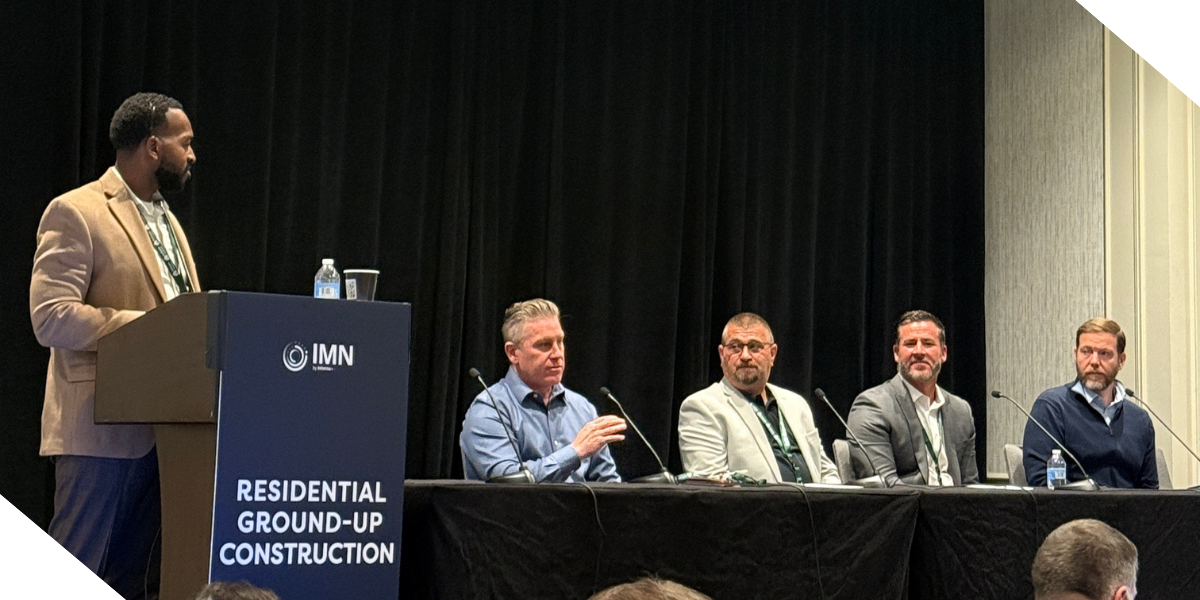
Key Insights from the IMN Residential Ground-Up Construction Conference
The IMN Residential Ground-Up Construction Forum is an important event for builders, lenders, and investors to examine the residential building market. Industry professionals gathered to address market changes, using data to inform financing decisions, identify cost efficiencies, and so much more.
Tom Hallock, Kiavi's VP, Head of Construction Lending, and Robert Jayne, Head of Originations, Construction Lending, contributed to several of IMN’s panel discussions. They shared their perspectives on financing strategies, market dynamics, and potential opportunities for builders and real estate investors.
Here are the top takeaways from the conference to help inform your new construction investment decisions—let’s dive in!
The Rise of Institutional Capital in Residential Construction
Institutional capital may be changing how residential projects receive financing, moving beyond traditional banks and lenders. This shift was a significant topic at the conference.
Tom Hallock, during the "The Institutional Credit Perspective" panel explained that advanced analytical tools and improved risk assessment methods are enabling institutional capital players to shape the future of ground-up construction project financing.
What might this mean for you?
- Increased capital availability due to securitizations: One speaker noted that the securitization market has shown significant growth, suggesting potential for more market development and more capital becoming available for construction financing deals.
- Customer experience matters: According to a forum speaker, businesses that prioritize customer satisfaction often secure substantial capital. This benefit also extends to builders, who often find better access to financing when they focus on tenant satisfaction.
- Liquidity is important: Tom Hallock highlighted that "liquidity and cash are crucial assets on a balance sheet." Institutional lenders typically assess borrowers based on their financial strength, with a focus on maintaining solid financial positions.
Build-to-Rent: Opportunity or Distraction for Small Builders?
The build-to-rent (BTR) market was a hot topic, with discussions covering both the opportunities and challenges for builders and real estate investors considering this strategy.
Key differences in BTR vs. traditional residential building:
- Tenant focus: A panelist highlighted that "The rental investor’s ultimate goal is to get tenants in their homes fast and get cash flow to a certain yield to hit a financial return. The retail customer's goal is to have a great house to live in." This changes design and construction approaches for the investor.
- Amenities: BTR is about "building a product that attracts a sticky tenant." Think community pools, fitness centers, and outdoor gathering spaces – these are investments to encourage longer tenancy.
Financing for BTR:
- Builders looking to finance Build-to-Rent (BTR) projects could consider starting with a new construction loan, such as those offered by Kiavi. These loans help to provide flexibility to cover construction costs and are tailored for builders focusing on new developments.
- Once the project is completed and stabilized, transitioning to a DSCR (Debt Service Coverage Ratio) loan could be a smart move. DSCR loans allow real estate investors to refinance based on the income potential of the property, providing long-term financing and steady cash flow opportunities.
For builders, evaluating BTR means carefully analyzing local rental markets, construction costs, and exit strategies. For real estate investors, BTR could offer reliable cash flow, but it requires a unique approach to financing and property evaluation compared to traditional residential development.
Accessing Capital in Today’s Market
The debt market for residential construction is evolving. At the 'Infill Strategies and Urban Edge Opportunities' panel, we heard that regional banks are pulling back on acquisition and development (A&D) loans, with much stricter underwriting. This shift could make it tougher to secure financing for future land and development projects from traditional financing sources such as banks.
For instance, one panelist shared an example of a $12 million loan from a regional bank that came with some pretty tight terms:
- Rate: Prime +3
- Term: 34 months
- Recourse: Non-recourse
- Equity: A 55% equity requirement
These conditions clearly show that some bank lenders are playing it safer these days. Plus, with an uptick in DSCR loan delinquencies, they might be even more hesitant about those products.
So, how do you navigate these conditions when traditional banks are tightening their belts? Avoiding over-leveraging and having a crystal-clear exit strategy are key. And, of course, nurturing strong relationships with various financing sources, including hard money lenders like Kiavi.
In a panel discussion, Robert Jayne explained how Kiavi helps real estate investors looking for residential transition loans (RTL), especially when traditional options are scarce. "We're looking for builders that have some experience," he said. "I think experience, liquidity... that's really important. Successful builders typically prioritize keeping money in the bank to offset unknown project and market conditions"
Ultimately, being transparent and having a detailed plan are essential. Lenders are going to scrutinize well-documented project plans, realistic timelines, and conservative financial forecasts before they approve any financing.
Infill Strategies and Urban Edge Opportunities
Infill development was a hot topic at the conference, and for good reason. Why were so many builders talking about it? Well, it could present a unique opportunity that could significantly benefit new construction investors. It’s all about understanding and leveraging your local advantages. For instance, as Robert Jayne pointed out, “builders who really know their municipality nuances and regulations and how to engage with them often find the best results.”
What makes infill so attractive? Imagine reduced infrastructure costs, revitalizing overlooked areas, and even forming powerful partnerships with Economic Development Corporations (EDCs). Plus, some states are even offering legislative support, opening up new possibilities for multi-family use in historically industrial or commercial zones.
Of course, it's not without its challenges.
You'll likely need to work closely with communities to address local concerns, and managing land prices and entitlements could be complex. But for real estate investors ready to tackle these hurdles, the rewards could be substantial. And for the right builders, Kiavi could help make these projects more accessible by offering high leverage on single assets. Are you ready to explore how infill could fit into your next build?
Technology Transforming the Builder's Toolkit
The "Tech That Works" panel highlighted some digital tools that could make builders' lives easier and more efficient.
Thinking about using technology in your investment strategy?
When considering adopting technology, the panel suggested keeping these points in mind:
- Align with Your Strategy: Your software choices should fit your company’s overall strategy. Don’t invest in technology without a plan on how it supports your business.
- Integrated vs. Best-in-Class Solutions: Integrated software packages can be cost-effective initially, but as your company grows, best-in-class solutions may better address specific needs.
- Specialized Systems: No single software solves all problems. Different systems excel at specific tasks.
- Cloud-Based Access: Cloud systems provide real-time access to information from anywhere, keeping everyone on the same page.
How could AI impact construction?
AI is generating a lot of interest across industries. Here are some ways the panelists thought it could potentially reshape ground-up construction:
- Streamlined 2D to 3D Modeling: Some AI-powered tools can now convert 2D PDFs into detailed 3D models quickly, providing accurate measurements for an entire house. This might significantly speed up estimating, budgeting, and project planning.
- Optimized Project Management: AI could analyze project data to help predict potential delays, budget overruns, and resource shortages. It could also automate scheduling and task allocation, helping ensure your crew and materials are where they need to be.
- Enhanced Job Site Safety: AI could be used to monitor job sites in real time. It could identify potential safety hazards, like workers not wearing proper protective gear or equipment being used unsafely, and send alerts to help prevent incidents.
- Automated Reporting and Documentation: AI could manage the process of generating daily progress reports, tracking expenses, and organizing project documentation. This could help free up your team to focus on more hands-on work.
Think of AI as a new team member – it often performs best with clear guidance, training, and the right oversight. With the right approach, it could significantly enhance your construction processes.
Construction Costs and Market Dynamics
What's happening with construction costs? According to several speakers at the IMN conference, costs for vertical construction have decreased by 3% to 5% in the last 12 months, and land development costs appear stable. As Robert Jayne noted, "Lower costs could boost project margins, creating more breathing room for investors."
But what about the market?
- Sales are slowing slightly, which could affect how quickly builders can sell investment properties.
- Foreclosures have increased this year in some areas as sales slow, which could create opportunities for well-capitalized real estate investors.
- One speaker in the panel discussions emphasized the value of land banking for maintaining strong balance sheets and managing risk.
- Capital is readily available for small to medium-sized developers, especially in the ground-up construction segment, according to another speaker in the panel discussions.
Understanding these market dynamics is important for your ground-up construction investment decisions and project planning. The combination of lower costs and available capital could create strategic opportunities.
What Lenders Are Looking For in 2025
When you approach lenders with a ground-up construction project, what exactly are they looking for? Panelists at the IMN conference shared some key insights on what they believe matters most.
Here’s what they had to say about evaluating projects:
- Lenders prioritize experience. Robert Jayne emphasized that lenders value your experience and liquidity as a builder.
- Be transparent. One speaker encouraged open communication with lenders to find solutions and avoid potentially tricky situations like cross-defaults.
- Technology could help. Better project monitoring technology could benefit both lenders, builders, and real estate investors, making processes more efficient.
If you're a builder seeking financing, here's what you might focus on:
- Maintain strong liquidity.
- Build your network and foster relationships with multiple lenders.
- Demonstrate your experience and a solid track record.
As Tom Hallock emphasized, "the sector's performance is key to continued capital inflow." Well-structured and performing loans could attract more capital, and delivering successful projects may lead to more favorable financing terms for you in the future.
Conclusion
The recent IMN Residential Ground-Up Construction Conference offered a clear look at where residential construction stands today and where it might be heading. Themes like institutional capital growth, build-to-rent projects, financing trends, infill strategies, technology, and cost management are all important. These insights could help shape your investment decisions and project plans.
Key takeaways for real estate investors and builders:
- Knowing your local market well could give you an advantage, especially in infill development.
- Having strong liquidity and good relationships with lenders is more important than ever.
- Using technology strategically could make your operations more efficient without big upfront costs.
- Consider comparing build-to-rent with traditional for-sale strategies. Consider your market, how you'll finance, and your exit plans.
- Infill projects in established areas may offer solid returns for those who grasp local rules and incentives.
When you're looking for construction financing, you'll want a partner who understands these trends. They should offer flexible, data-driven solutions that work for you. Being successful in residential building often means adjusting to market changes while keeping your core business principles in focus.
Want to explore financing options that fit your goals? Get pre-qualified online with Kiavi in just a matter of minutes.
Frequently Asked Questions (FAQs)
Q: What are the benefits of infill development in ground-up construction?
A: Infill development offers:
- Reduced infrastructure costs.
- Opportunities to revitalize areas.
- Potential partnerships with EDCs.
Successful infill builders understand municipal advantages and local markets. For attractive financing options for residential new construction builders, visit Kiavi's New Construction Infill loans for more information.
Q: How has the construction lending landscape changed in 2025?
A: According to multiple speakers at the IMN Residential Ground-Up Construction conference, fewer regional banks are offering A&D loans, underwriting is becoming stricter, and DSCR loan delinquencies have increased. However, capital remains available for experienced builders with strong liquidity and transparent operations.
Q: How can I finance new construction investments with low down payment options?
A: Securing financing for new construction projects with a low down payment can be challenging, as traditional lenders often have strict underwriting requirements. However, specialized lenders offer more flexible options for experienced builders.
For example, Kiavi provides new construction loans designed for real estate investors. At the time of writing this, Kiavi offers financing for up to 85%* of total costs (purchase price + construction costs) and up to 100%* of the rehab price, which could significantly reduce your initial cash outlay. Their process is tailored for builders, focusing on speed and transparency to help you get your project off the ground faster.
You can find more details about their specific loan products here: https://www.kiavi.com/loans/new-construction-infill

